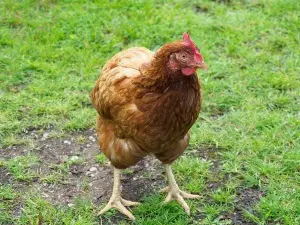
A variety of ailments can cause your chicken to develop leg or foot problems. Some of these ailments are more serious than others, and some, if not addressed, can be fatal to the bird.
If your bird has black spots on its legs this article will help you figure out why.
Table of Contents
Black spots on chicken legs:
Black spots developing on your chicken’s legs may come as a surprise to you, reasons why this happens, include:
Normal coloring:
Chickens come in a variety of different colors, a bird may not only have different feather coloring but the bird may also have slightly different skin coloring. This abnormal skin coloring may simply be something on your bird that you hadn’t yet noticed.
What to do:
Take a look at the pictures of when you first received your bird and compare them to how your bird looks now. If the coloring was visible when you first bought the bird then you don’t have to worry.
Just to make sure, it may also be helpful to contact the breeder who you bought the bird from to make sure that the black spots are indeed simply the bird’s natural pigment.
You don’t have to worry about anything as long as your bird had these black spots when you first got it and as long as the bird is acting normally and isn’t showing any other signs of being ill.
The black spots may simply be a defect on your bird that was not bred out.
This type of pigment is common in barred rock chickens. If you’re raising barred rocks then that may be what’s going on with your bird.
That being said, other chicken species, who aren’t barred rock chickens, may also have this same dark coloring on their legs, this coloring isn’t necessarily specific to barred rock chickens.
Fowl pox:
If the black spots on your bird’s legs are raised and have the texture of a scar then the bird may have fowl pox.
Fowl pox is a highly contagious disease that causes birds to develop lesions on the non-feathery parts of their bodies. These lesions are painful and can develop on the chicken’s comb, wattle, eyelids, face, and legs.
Fowl pox is a viral infection that can be life-threatening if not addressed.
It’s a disease that spreads slowly in a flock, but because the virus is carried in the bird’s hot debris, fallen scabs, dander, and secretions, it can exist within your flock over weeks, months, and years.
Healthy birds will inhale, eat or touch the hot debris, fallen scabs, dander, or secretions and become sick with fowl pox.
In the early stages, the disease will cause the bird to develop lesions that look like blisters on some, or all, of the bird’s non-feathery body parts. These lesions can develop on the bird’s eyelids, wattle, comb, face, or legs.
These lesions will eventually turn yellow and after this, will then turn into scabs which may be what you are seeing.
Other signs of a bird suffering from this ailment include a loss of appetite, fewer eggs being produced, and lesions in the bird’s throat.
What to do:
Unfortunately, there is no fowl pox cure but you can do your best to keep further infections at a minimum. Vaccinations can be given to your healthy birds if an outbreak occurs.
Cleaning the coop on a regular basis will keep the hot debris at a minimum. Sanitizing the birds drinking water is recommended and mixing a diluted iodine solution into your bird’s drinking water is also recommended.
Your sick birds can be given an antibiotic to keep secondary infections at bay. You’d need to contact your vet and have them see your bird to get an antibiotic prescription.
The bird’s sores and scabs can be treated with an ointment to soften them. The scabs can also be treated using a diluted iodine solution
If you enjoyed this article then you may also be interested in other chicken related articles. Here are some articles that you may be interested in: Chicken Attacked By A Dog And Is In Shock, Open Wound On Chickens Neck, Chickens Wound Smells, Vetrx For Scaly Leg Mites, Dislocated Hock Joint Chicken, Baby Chick Is Limping,

